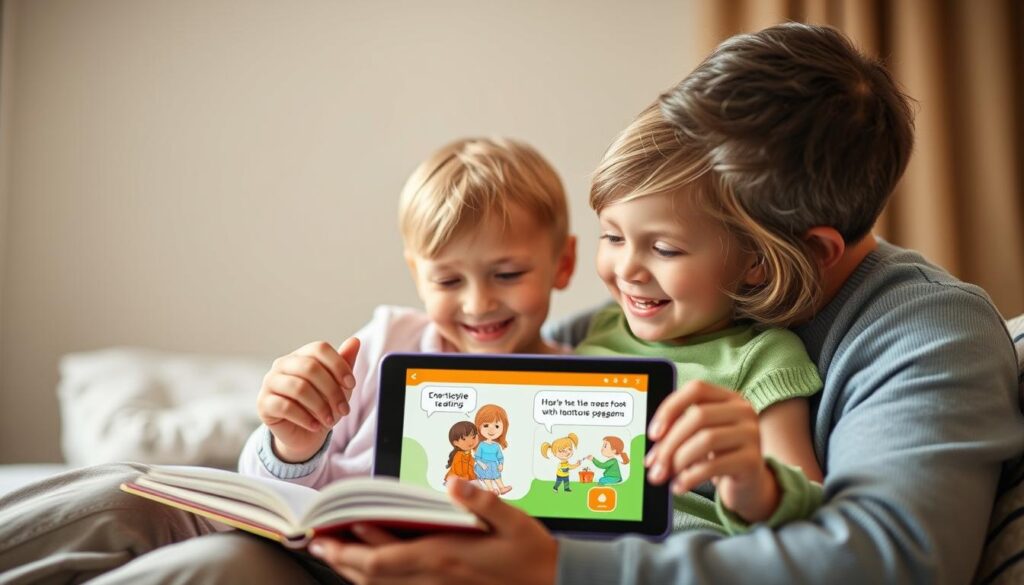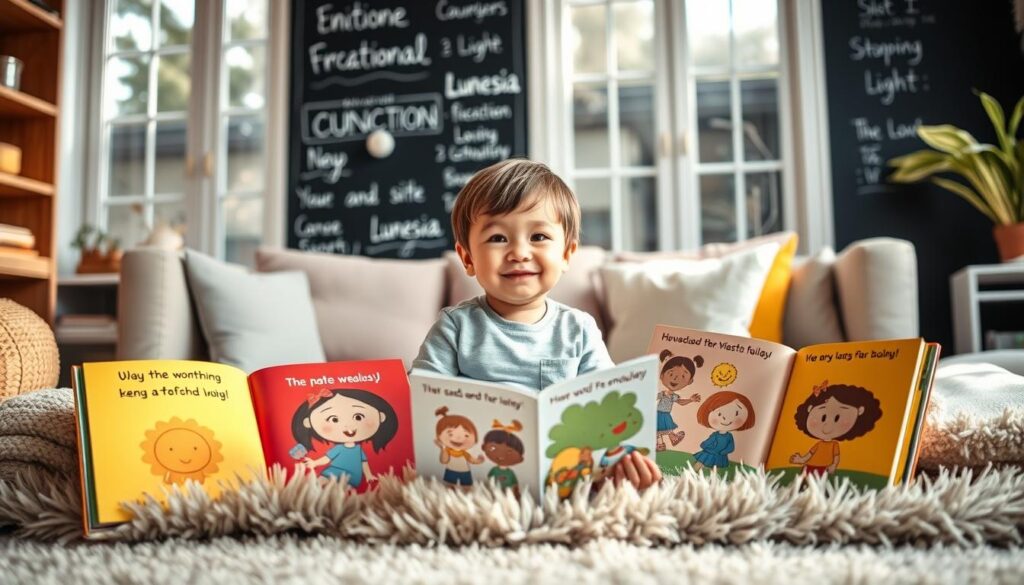As a parent, have you ever watched your child’s emotions shift like the wind, leaving you wondering how to help them anchor their feelings in a safe harbor? Children experience the world intensely, and their emotions can change rapidly, often without warning.
I’ve seen firsthand how kids struggle to understand their emotions, which is why interactive tales have become a valuable tool. These stories help children develop emotional intelligence, coping skills, and mindfulness, creating a safe space for them to explore complex emotions.
In this article, I’ll share how these engaging stories can help your child navigate their emotions in a healthy way, expanding their emotional vocabulary and developing crucial empathy skills.
The Challenge of Big Feelings in Child Development
As a parent, recognizing the signs of big feelings in your child is essential for their emotional growth. Children often struggle to understand and manage their emotions, leading to behaviors that can be challenging to navigate. Some kids have a natural inclination towards empathy, while others may find it harder to grasp emotions beyond their own experiences.
How Children Process Emotions Differently Than Adults
Children process emotions differently than adults, often lacking the vocabulary to express their feelings. This can lead to frustration and meltdowns. By understanding this difference, we can better support our children in developing emotional regulation skills.
Signs Your Child Is Struggling with Big Feelings
You might notice your child becoming easily frustrated or having frequent meltdowns over small things. Other signs include changes in sleep patterns, appetite, or physical complaints. Withdrawal from enjoyable activities or regression to younger behaviors can also signal emotional struggles. For more resources on supporting your child’s emotional journey, you can visit Lunesia’s website.
How Lunesia’s Interactive Tales Support Emotional Learning

By leveraging interactive storytelling, Lunesia provides a powerful tool for emotional learning in children. The Storypod is an interactive audio device specially designed for kids, engaging multiple senses and maintaining their attention during emotional learning.
The Philosophy Behind Lunesia’s Approach
Lunesia’s approach is centered on creating a comprehensive emotional learning ecosystem. This involves using relatable characters and stories to address various emotions, such as anxiety, frustration, and joy, helping kids understand and manage their feelings.
Features of Lunesia’s Storypod and Emotion-Focused Content
The Storypod offers a range of content types, including Board Books, Card Sets, and Picture Books, all designed to support emotional learning. The interactive elements prompt reflection and discussion, deepening emotional understanding and helping kids develop essential emotional intelligence skills throughout the day.
Creating a Safe Space for Emotional Expression
A safe space for emotional expression can be a game-changer for children struggling with big feelings. Even though things seemed impossible on a ‘very bad day’ last week, it no longer feels quite as hard to deal with. Big concepts – like grief, loss, pain, illness, and anger – get better with time and attention. By creating a supportive environment, you can help your child navigate their emotions more effectively.
Setting Up Daily Emotional Check-ins with Your Child
Establishing daily emotional check-ins with your child can provide them with a sense of security and understanding. This practice allows you to share in their feelings and offer guidance on managing their emotions. By doing so, you create a routine that fosters emotional intelligence and a deeper connection.
Using Lunesia’s Tales as Conversation Starters
Lunesia’s stories offer a neutral ground for discussing difficult emotions. For instance, instead of asking “Why were you angry today?” you can ask “Remember how Theo felt frustrated in the story? Have you ever felt that way?” This approach helps kids relate to the characters’ experiences and articulate their own feelings. By using these tales as conversation starters, you can encourage your child to open up and share their emotional experiences.
| Benefits of Lunesia’s Tales | Impact on Children |
|---|---|
| Provides neutral ground for discussing emotions | Helps kids relate to characters’ experiences |
| Creates a shared emotional vocabulary | Facilitates understanding and articulation of feelings |
| Encourages reflection and connection to personal experiences | Fosters emotional intelligence and deeper parent-child connection |
Step-by-Step Guide to Using Lunesia to Understand Big Feelings

With Lunesia’s Storypod, you can create a safe and interactive environment for your child to explore and understand their emotions. This step-by-step guide will help you make the most out of Lunesia’s interactive tales.
Selecting the Right Tales for Your Child’s Emotional Needs
Choose stories that address your child’s current emotional challenges. Lunesia’s diverse range of tales ensures there’s something for every child’s needs, helping them understand and manage their feelings effectively.
Interactive Reading Techniques That Encourage Reflection
As you read with your child, pause to ask open-ended questions about the story. This encourages them to reflect on the characters’ emotions and relate them to their own experiences, fostering a deeper understanding of emotional intelligence.
Follow-Up Activities to Reinforce Emotional Lessons
After reading, engage your child in activities like drawing their favorite character’s emotion, role-playing scenarios, or maintaining a feelings journal. These exercises help reinforce the emotional lessons learned, making them a valuable tool for your child’s emotional development.
Expanding Your Child’s Emotional Vocabulary with Lunesia
One of the most effective ways to support your child’s emotional growth is by enhancing their emotional vocabulary. A rich emotional vocabulary helps children identify and articulate their feelings more effectively.
Moving Beyond “Good” and “Bad” to Specific Feeling Words
Teaching your child to move beyond generic terms like “good” or “bad” to more specific emotions like frustration, excitement, or disappointment can significantly enhance their emotional understanding. For instance, using songs like the “Feelings Song” for younger kids or “These Are My Feelings” for older kids can be a fun and engaging way to introduce a broader range of emotional words.
Using Lunesia’s Characters as Emotional Reference Points
Lunesia’s characters become emotional touchstones for children. When your child says, “I’m feeling like Theo when he couldn’t build his tower,” it’s a sign that they’re developing a more nuanced understanding of their emotions. You can further support this by connecting their feelings to story characters: “You seem frustrated like Bunny was when she couldn’t tie her shoes. Is that how you feel?”

Over time, these character references can be gradually replaced with more sophisticated emotional language as your child’s vocabulary and self-awareness grow.
| Emotional Vocabulary Benefits | How Lunesia Supports |
|---|---|
| Enhanced emotional understanding | Using specific feeling words |
| Better articulation of feelings | Lunesia’s characters as emotional references |
| Improved emotional regulation | Connecting feelings to story characters |
Practical Strategies for Managing Different Types of Big Feelings
Helping children understand and manage their big feelings is a journey that requires patience, empathy, and effective strategies. As a parent, you play a significant role in teaching your child how to navigate these emotions.
Techniques for Handling Sadness and Disappointment
When your child is feeling sad or disappointed, it’s essential to acknowledge their emotions. Encourage them to express their feelings, and offer comfort and support. You can also engage them in activities that help shift their focus, such as drawing or storytelling.
Approaches for Managing Anger and Frustration
For anger and frustration, teach your child healthy ways to express these emotions, such as through physical activity or creative play. Encourage them to identify what triggered their anger and work on resolving the root cause.
Methods for Addressing Anxiety and Fear
To address anxiety and fear, normalize these feelings by explaining that they’re common and manageable. Teach your child grounding techniques like the 5-4-3-2-1 method to bring them back to the present moment. Creating worry rituals, such as a “worry monster” that “eats” written worries, can also be helpful.
| Emotion | Strategy | Benefit |
|---|---|---|
| Sadness/Disappointment | Acknowledgment and comfort | Emotional validation |
| Anger/Frustration | Physical activity/creative play | Healthy expression |
| Anxiety/Fear | Grounding techniques/worry rituals | Anxiety reduction |
Using Lunesia to Help Children Understand Big Feelings in Others
Empathy is a vital skill for children to learn, and Lunesia’s interactive stories make it an enjoyable experience. By engaging with Lunesia’s tales, kids can develop a deeper understanding of others’ emotions, fostering a more compassionate and supportive environment.
Building Empathy Through Character Perspectives
Lunesia’s stories allow children to explore different characters’ feelings and perspectives, helping them understand that everyone experiences emotions differently. For instance, a story about a character dealing with loss can help kids empathize with peers who are going through a similar situation. You can explore more stories on coping with emotions here.
Role-Playing Activities Inspired by Lunesia’s Stories
Role-playing scenarios from Lunesia’s stories enables children to practice emotional responses in a safe context. You can set aside special time for “feelings theater” where you act out challenging scenarios and brainstorm different responses. Using puppets or stuffed animals to represent characters can also help. For example, you can ask, “What would you do if someone at school was playing alone like Bunny was in the story?”
| Activity | Benefits |
|---|---|
| Role-playing | Practices emotional responses in a safe context |
| “Feelings theater” | Encourages brainstorming different emotional responses |
| Using puppets or stuffed animals | Helps reserved children participate without direct performance pressure |

Conclusion: Supporting Your Child’s Emotional Journey with Lunesia
Understanding and managing big feelings is a crucial life skill that Lunesia helps children develop. As parents, you’re not just teaching your child about feelings today; you’re shaping how they’ll understand and process emotions as adults.
By using Lunesia’s interactive tales consistently, you’re creating a foundation for lifelong emotional health. This journey requires patience and understanding, but the payoff is significant. The time you invest now will lead to healthier relationships and greater resilience in your child’s future.
Remember, emotional education is not separate from “real” learning; it’s the essential foundation that supports all other development. By supporting your child’s emotional journey with Lunesia, you’re helping them become balanced, empathetic individuals.
FAQ
How can I help my child manage their emotions when they’re feeling overwhelmed?
You can help your child by creating a safe space for emotional expression, such as setting up daily emotional check-ins. This can be a great way to encourage your child to share their emotions and develop a deeper understanding of their emotional state.
What are some signs that my child is struggling with their emotions?
Some common signs include changes in behavior, such as becoming more withdrawn or aggressive, or expressing anxiety or fear. You can also look out for physical symptoms like headaches or stomachaches, which can be related to emotional stress.
How can I use interactive tales to support my child’s emotional learning?
Interactive tales can be a powerful tool for supporting emotional learning. By using stories that feature characters experiencing different emotions, you can help your child develop empathy and understand different emotional perspectives.
What are some techniques for handling sadness and disappointment in children?
One approach is to validate your child’s emotions, acknowledging their sadness or disappointment and offering comfort. You can also encourage your child to express their emotions through creative activities like drawing or writing.
How can I help my child develop a more nuanced emotional vocabulary?
You can help your child by introducing specific feeling words, such as “frustrated” or “excited,” and encouraging them to use these words to describe their emotions. Using character perspectives from interactive tales can also be a helpful way to illustrate different emotional states.
What are some ways to encourage my child to reflect on their emotions?
One approach is to use interactive reading techniques, such as asking open-ended questions about the story or encouraging your child to predict what might happen next. You can also use follow-up activities, like role-playing or drawing, to reinforce emotional lessons.




